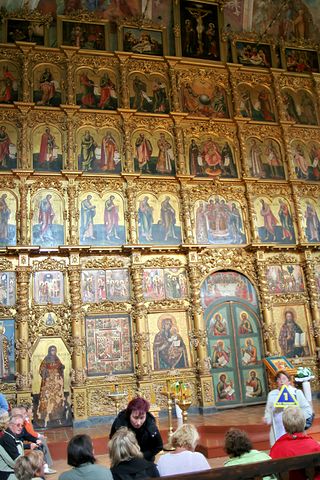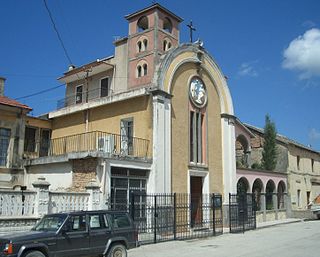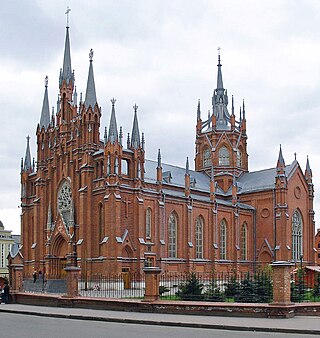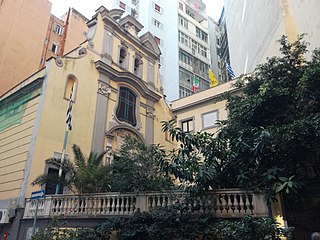Byzantine Church or Byzantine church may refer to:

Eastern Christianity comprises Christian traditions and church families that originally developed during classical and late antiquity in Western Asia, Asia Minor, Eastern Europe, Southeastern Europe, the Caucasus, Northeast Africa, the Fertile Crescent and the Malabar coast of South Asia, and ephemerally parts of Persia, Central Asia and the Far East. The term does not describe a single communion or religious denomination.
The Byzantine Empire was the medieval Eastern Roman empire, that evolved after the fall of the Western Roman Empire in the 5th century.

The Eastern Catholic Churches or Oriental Catholic Churches, also called the Eastern-Rite Catholic Churches, Eastern Rite Catholicism, or simply the Eastern Churches, are 23 Eastern Christian autonomous particular churches of the Catholic Church, in full communion with the Pope in Rome. Although they are distinct theologically, liturgically, and historically from the Latin Church, they are all in full communion with it and with each other. Eastern Catholics are a distinct minority within the Catholic Church; of the 1.3 billion Catholics in communion with the Pope, approximately 18 million are members of the eastern churches.

An exarch was the holder of any of various historical offices, some of them being political or military and others being ecclesiastical.
The "Greek Orthodox Church" is a Christian term that can refer to any one of three classes of church, each associated in some way with Greek Christianity or the Eastern Roman Empire.
Eparchy is an ecclesiastical unit in Eastern Christianity that is equivalent to a diocese in Western Christianity. An eparchy is governed by an eparch, who is a bishop. Depending on the administrative structure of a specific Eastern Church, an eparchy can belong to an ecclesiastical province, but it can also be exempt. Each eparchy is divided into parishes, in the same manner as a diocese in Western Churches. Historical development of eparchies in various Eastern Churches was marked by local distinctions that can be observed in modern ecclesiastical practices of the Eastern Orthodox Church, Oriental Orthodox Churches and Eastern Catholic Churches.

The Byzantine Rite, also known as the Greek Rite or the Rite of Constantinople, is a liturgical rite that is identified with the wide range of cultural, devotional, and canonical practices that developed in the Eastern Christian church of Constantinople.

The Ruthenian Greek Catholic Church, also known in the United States as the Byzantine Catholic Church, is a sui iuris (autonomous) Eastern Catholic church based in Eastern Europe and North America. As a particular church of the Catholic Church, it is in full communion with the Holy See. It uses the Byzantine Rite for its liturgies, laws, and cultural identity.

The Albanian Greek Catholic Church or the Albanian Byzantine Catholic Church, is an autonomous Byzantine Rite particular church in full communion with the Catholic Church and the Pope of Rome, whose members live in Albania and which comprises the Apostolic Administration of Southern Albania. The Albanian Greek Catholic Church, with its Byzantine Rite, is closely linked to the Italo-Albanian Catholic Church sharing a significant commonality of history, identity and traditions.

The term Melkite, also written Melchite, refers to various Eastern Christian churches of the Byzantine Rite and their members originating in the Middle East. The term comes from the common Central Semitic root m-l-k, meaning "royal", referring to the loyalty to the Byzantine emperor. The term acquired religious connotations as denominational designation for those Christians who accepted imperial religious policies, based on Christological resolutions of the Council of Chalcedon (451).

The Russian Greek Catholic Church or Russian Byzantine Catholic Church is a sui iuris Byzantine Rite Eastern Catholic Church of the worldwide Catholic Church. Historically, it represents a both a movement away from the control of the Church by the State and towards the reunion of the Russian Orthodox Church with the Catholic Church. It is in full communion with and subject to the authority of the Pope of Rome as defined by Code of Canons of the Eastern Churches.
Eastern Rite or Eastern liturgical rite may refer to:
Georgian Byzantine Rite Catholics, or members of the Georgian Greek Catholic Church, are Catholics from the Georgian people who practice the Byzantine Rite in Old Georgian, which is also the liturgical language of the Georgian Orthodox Church.

Eastern Orthodox church architecture constitutes a distinct, recognizable family of styles among church architectures. These styles share a cluster of fundamental similarities, having been influenced by the common legacy of Byzantine architecture from the Eastern Roman Empire. Some of the styles have become associated with the particular traditions of one specific autocephalous Eastern Orthodox patriarchate, whereas others are more widely used within the Eastern Orthodox Church.

The following outline is provided as an overview of and topical guide to the Byzantine Empire:

The Coptic Rite is an Alexandrian liturgical rite. It is practised in the Coptic Orthodox Church and the Coptic Catholic Church.
Ruthenian Catholic Church may refer to:
Ukrainian Catholic Church may refer to:

Santi Pietro e Paolo dei Greci is a church at the Campania, the historic center of Naples, in Via San Tommaso d'Aquino 51. It was the center of the Scuola dei Greci in Naples and the Confraternity of the Greeks in Naples. Around this period there was a similar church in Venice called San Giorgio dei Greci. There was also a Greek Brotherhood of Venice. A prominent member of the Greek Brotherhood was famous painter Belisario Corenzio. The church was initially dedicated to the Twelve Apostles. They began building the church at the request of one of the descendants of the Byzantine Empire Thomas Asen Palaiologos. The church currently belongs to the Greek State.
The Eastern Catholic Churches of the Catholic Church utilize liturgies originating in Eastern Christianity, distinguishing them from the majority of Catholic liturgies which are celebrated according to the Latin liturgical rites of the Latin Church. While some of these sui iuris churches use the same liturgical ritual families as other Eastern Catholic churches and Eastern churches not in full communion with Rome, each church retains the right to institute its own canonical norms, liturgical books, and practices for the ritual celebration of the Eucharist, other sacraments, and canonical hours.